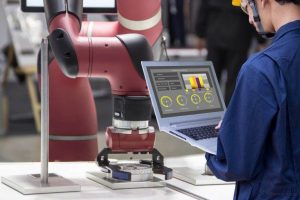 The world is experiencing one change after another, and technology seems to be the one to thank for that. People are finding ways to incorporate those changes not only in their everyday lives, but also in their business operations. In fact, especially in the latter, because that can often make the difference between a successful business and an unsuccessful one.
The world is experiencing one change after another, and technology seems to be the one to thank for that. People are finding ways to incorporate those changes not only in their everyday lives, but also in their business operations. In fact, especially in the latter, because that can often make the difference between a successful business and an unsuccessful one.
For instance, nowadays, everyone is talking about the Internet of Things (IoT). A concept, defined on this page, that has proven to be a transformative force across numerous industries. The manufacturing industry certainly couldn’t escape the force. Or better yet, it didn’t want to.
Put simply, the manufacturing industry has also felt the changes that the IoT has brought about. The technology is reshaping the whole manufacturing process, improving efficiency and connectivity, as well as facilitating the decision-making process by introducing the relevant data that lead towards making informed moves and creating data-driven strategies. If you are a part of this industry, you should definitely understand the role of IoT better.
In short, there are a few important things to know about the IoT in manufacturing. And, if you are ready to learn, then you’ve come to the right place, because below I’ll answer the most significant questions that probably most of the players in this industry have on their minds, especially upon first hearing about the concept. What you will do with the knowledge next is up to you, although we all know that keeping up the pace is a must, and that using the innovations and tech developments can do wonders for your business.
What Is IoT in Manufacturing?
So, as mentioned, there are some quite important things to know about the IoT in manufacturing. We are here to begin with the very basics, defining this concept and its use in the specific industry we are talking about.
If you’re looking for the definition of the concept outside of the industry, this should help: https://www.techtarget.com/iotagenda/definition/Internet-of-Things-IoT
Anyway, the IoT in manufacturing entails the integration of devices, sensors, and machinery, with the aim of creating a network through which to easily communicate and share data. It allows for collecting and exchanging data in real time, which enables a completely seamless flow of information across the entire production chain. Therefore, it allows manufacturers to increase productivity, as well as enhance the supply chain operations.

What Are the Benefits of Implementing IoT in Manufacturing?
Now, since you’ve gotten a bit of a clearer picture on how the IoT works in manufacturing, you’re wondering what the actual benefits are. Chances are you already have some ideas about this, but you want them to be put into words. You want the benefits clearly outlined, so that you can understand what to expect from this type of a network should you create it.
First and foremost, there is the enhanced operational efficiency. The sensors will monitor the conditions of the equipment, thus predicting any potential problems before they cause serious issues, thus allowing for timely maintenance and, consequently, reducing downtime. Plus, the real time data will optimize the production process, maximizing the overall efficiency, which is definitely a big deal for any manufacturing business out there.
Furthermore, these solutions facilitate the tracking of the raw materials, of works in progress, as well as of finished goods. Meaning, in few words, that the IoT in manufacturing also serves to increase visibility of the inventory levels and help you track and manage the inventory much better. You will get to reduce excess stock, and to process and fulfill orders more successfully. Also, to enhance your supply chain visibility you can always consider port terminal visibility that diminishes the idea of missing pieces in transportation.
On top of all this, you will also get to monitor the product quality at all stages of the manufacturing process. Thus, you will minimize defects and ensure that everything adheres to the industry standards. And then, the IoT devices can also come to the root of the defects, helping you not only identify the causes, but also implement targeted improvements.
Here is something that you will absolutely love about these devices. They can save your business money. First off, the devices will contribute to energy savings by optimizing the usage of the equipment. And then, the IoT data leads to more efficient resource management, which can result in reducing costs in materials, maintenance, and labor.
What Are the Key Components to Use?
Wondering what the key IoT components to use in manufacturing are? That is, what it is that you should think about getting? Let me give you a clearer idea on that, with a quick reminder that you should always explore all the devices, with the aim of determining if they fit in with your needs and requirements before you do the shopping.
Sensors and actuators help collect data and take actions based on the received data. Then, there are communication protocols and wireless technologies that make communication easier. Of course, don’t forget data storage, analytics, and cloud computing in general, as it allows for remote access, as well as for better storage and better collaboration.
